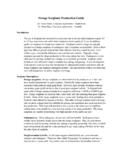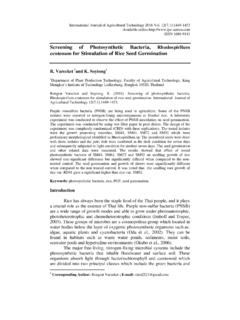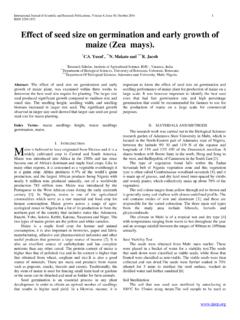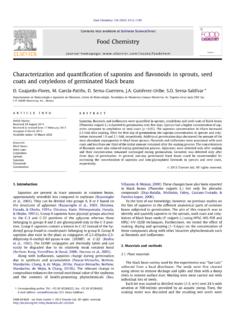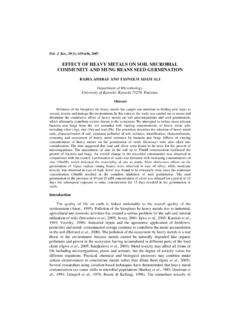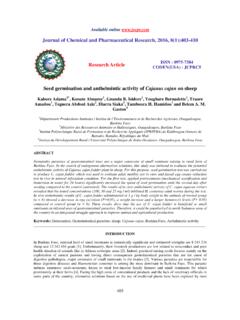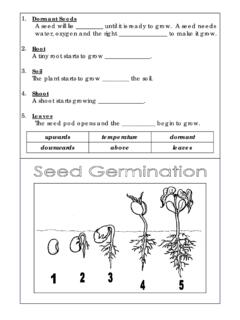Transcription of Alfalfa Germination and Growth - Soil, Crop and More
1 Dan UndersanderPaul VassalottiDennis CosgroveA3681germination & growthAlfalfaUnderstanding Alfalfa Germination and growthis important to matching management deci-sions to Alfalfa development. Knowledge ofthe Germination process will help you under-stand conditions necessary for good standestablishment and reasons for delayed orfailed establishment. Knowledge of seedlinggrowth will help you determine when to takeremedial action to control diseases, insects,and weeds. Understanding the patterns ofspring greenup and regrowth after cuttingwill aid in determining the presence of disease problems or winter injury and inmanaging weeds. Knowledge of mature stagesof Alfalfa will aid in harvest decisions for thedesired forage quality.
2 As the radicle grows, the portion near-est the seed enlarges and forms ahook. It pushes up through the soilsurface, dragging the cotyledons andseed coat with it. Once the seedling emerges aboveground and is exposed to light, itstraightens out. At the same time,small root hairs are developing on thelower radicle. The root hairs absorbwater and nutrients from the soil. Supplying the right conditions foralfalfa seeds will help to assure max-imum Germination . Prepare a firm,weed-free seedbed to minimize competi-tion from weeds and to ensure goodseed-soil contact. Avoid overworking thesoil surface as rainfall following seedingmay crust the surface, preventingseedling emergence. Place seeds 1 4- to1 2-inch deep in medium and heavy tex-tured soils and 1 2- to 1-inch deep insandy soils.
3 These depths cover the seedswith enough soil to provide moist con-ditions for Germination while allowingthe small shoot to reach the surface. Soiltemperature must be above 37 F for theseed to begin taking up water. Highersoil temperatures increase the rate ofgermination but do not affect the finalgermination percentage. High soil saltcontent will prevent the plant from tak-ing up water and Germination & GROWTHGERMINATION & EMERGENCE3 Germination and emergenceThe seed on the right is swollen withwater taken up from the soil. Thisprocess marks the first step in seedgermination. Under favorable condi-tions, water uptake begins within 24to 48 hours after planting. The first part of the seedling toemerge is the root radicle. The radicleanchors the seedling in the soil andalways grows downward, regardlessof the direction it s pointing in when itfirst comes out of the seed.
4 Young seedlings are particularly vul-nerable to diseases and herbicidedamage. As the seedlings mature,they become more resistant to seedlingdiseases and less susceptible to herbicidedamage. Many herbicides have applica-tion restrictions until a specific growthstage is reached. It is important to beable recognize each Growth stage so youcan apply treatments at the correct Germination & GROWTHSEEDLING DEVELOPMENT & GROWTH5 Seedling development and growthThe second leaf to appear has three leaflets. This is called atrifoliate leaf. Most subsequent leaves are trifoliate, althoughsome varieties produce leaves with four or more leaflets perleaf that are called multifoliate plant is at the three-leaf stage. Note the three trifoliateleaves in addition to the unifoliate leaf.
5 At this stage, theseedling can manufacture all of its energy through first true leaf to develop on analfalfa seedling has just one leafletand is called the unifoliate leaf. Cotyledons are usually the first visibleportion of an Alfalfa seedling abovethe soil surface. Even brief exposures to air tempera-tures below 27 F will kill youngalfalfa seedlings. Alfalfa plants sur-vive cold temperatures by pulling thelowermost buds below ground to form acrown. This process, called contractilegrowth, begins two to six weeks aftergermination. To allow enough time forcrown development, avoid seeding afterthe recommended late-summer plantingdates. Plants that have not formed acrown will not survive the winter. Crown development has not yet begunon this young plant. The cotyledons,though brown, are still present.
6 Notethe distance between nodes in thispicture compared to those of the plantat right. The lowermost buds have been pulledbelow ground to form the development on this plant isalready sufficient for winter crown will continue to enlargethroughout the life of the plant. Counting only thefully expandedtrifoliate leaves,this plant is atthe five-leafstage. A leaf isconsidered fullyexpanded whenthe outer edgesof all leaflets areno longer four weeks after Germination , ifRhizobiumbacteria is present, roundstructures called nodules will form onalfalfa roots. The bacteria help theplant use nitrogen from the air in aprocess known as nitrogen Germination & GROWTHCROWN FORMATION & DEVELOPMENT7 Crown formation and developmentThe plant on the left has suffered win-ter injury while the plant on the righthas not.
7 Injured plants are less vigor-ous and slow to recover. In addition, ifcrown buds have been killed, the plantmust form new buds to replace them. Uneven (asymmetrical) Growth is asymptom of winter injury. The crownbuds on the right side of this planthave been killed by cold damage is often found on older,diseased plants. This plant will be lessvigorous and lower yielding than ahealthy plant. Spring Growth ideally comes fromcrown buds formed the previousyear during late summer and occurs when buds located onthe crown begin to grow in response towarm spring temperatures. In additionto weather, the timing of spring greenupdepends on plant health, the genetic falldormancy of the variety, and theamount of dormancy developed in theplants during the fall (determined by fallweather conditions).
8 If plants areinjured or slow to greenup, considerplanting more winterhardy well-developed crown showshealthy crown buds growing to produce the season s first cutting. 8 Alfalfa Germination & GROWTHSPRING GREENUP9 Spring greenupForage yield, quality, and stand persis-tence are considerations for decidingwhen to cut. Forage yield increasesuntil the plant reaches full flower, whileforage quality decreases continually dur-ing Growth or regrowth (see figure). Theoptimum balance between yield andquality depends on the cutting and for-age quality desired. Early in the growingseason, plants may not flower normallyand quality may decline even thoughthe plant is not flowering. Therefore,take the first cutting of the season basedon quality or by date (if quality infor-mation is not available).
9 Take later cut-tings based on Growth stage or by timeinterval (35 to 45 days). The optimum yield and foragequality for milking dairy cows rangesfrom vegetative to early bud on the firstcutting to 10% flower on the secondand third cuttings to full flower on alate-fall cutting. For animals with lowernutritional requirements, later stagesmay be harvested. The pictures on thefollowing pages depict Growth stagescommonly referred to when discussingcutting after cutting arises fromcrown buds and from axillary buds are found in leafaxils, where the leaf joins the stem. Theideal cutting height is at least 2 inchesabove the soil surface. This height leavesaxillary buds for regrowth. Lower cut-tings will force regrowth to come fromcrown buds only, reducing yield of thenext cutting.
10 Short cutting intervals (lessthan 35 days) will also reduce the num-ber of axillary buds. Moisture stressimmediately after cutting will reducethe number of crown and axillary budsand, therefore, stem density and yieldavailable for harvest, even if rain occurslater in the Growth from axillary buds andcrown Germination & GROWTHWHEN TO CUT11 Growth after cuttingWhen to cutforage yieldfirst-cut forage qualitylate-season forage qualityvegetativebudfirst flowerfull-flowerpost-flowerForage yield and quality at various stages of growthLate budAt the late-bud stage, flower buds arelarge and lengthening rapidly. Budsbegin developing at three or more leafaxils lower on the stem. WHEN TO CUT13 Early budThe flowering process begins whensmall buds form in the top one or twoleaf axils.
